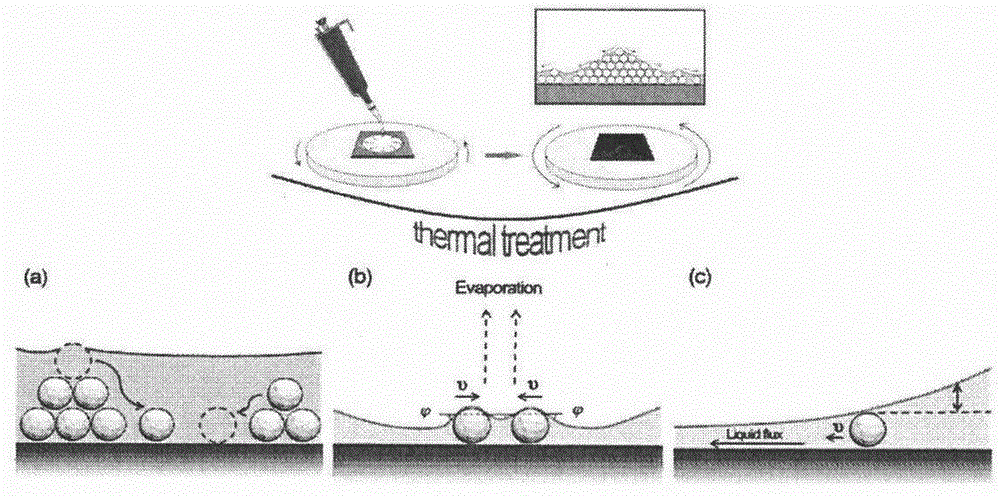Colloidal-single-crystal-self-assembly computer simulation method based on heat-treatment assistance and preparing method of colloidal single crystals
A simulation method and self-assembly technology, applied in the direction of single crystal growth, self-gel state, chemical instruments and methods, etc., can solve problems such as difficulties, achieve the effect of improving quality and saving financial and material resources
- Summary
- Abstract
- Description
- Claims
- Application Information
AI Technical Summary
Problems solved by technology
Method used
Image
Examples
Embodiment 1
[0059] Example 1: Effects of different dispersion systems (ethanol, water, mixture of ethanol and ethylene glycol) on the assembly of monolayer colloidal crystals with polystyrene beads with a diameter of 460 nm.
[0060] (1) Clean the substrate according to the standard RCA procedure;
[0061] (2) Hydrophilic treatment of the cleaned substrate, putting it into a mixed solution of hydrogen peroxide and concentrated sulfuric acid;
[0062] (3) The preparation of glue concentration is 3% ethanol, water, the mixture of ethanol and ethylene glycol. Disperse polystyrene beads with a diameter of 460 nm in the three solvents
[0063] (4) Set the parameters of the glue homogenizer as: rotating speed (300 rpm) and glue homogenization time (6 seconds), put the substrate in the glue homogenizer and coat the glue film;
[0064] (5) Constant temperature treatment of the sample: the sample after homogenization is placed in a constant temperature device, and the temperature is controlled a...
Embodiment 2
[0067] Example 2: Polystyrene beads with a diameter of 460 nm were assembled into a single-layer colloidal crystal.
[0068] (1) Clean the substrate according to the standard RCA procedure;
[0069] (2) Hydrophilic treatment of the cleaned substrate, putting it into a mixed solution of hydrogen peroxide and concentrated sulfuric acid;
[0070] (3) Prepare a mixed solution of ethanol and ethylene glycol, which is infiltrated with the substrate and the beads and is not volatile, and infiltrates the polystyrene beads with a diameter of 460nm to obtain a glue solution with a concentration of 10%;
[0071] (4) Monte Carlo simulation is carried out by computer to simulate a suitable self-assembly temperature. When simulating, first input the diameter of the ball R=460nm, U 0 =200, the energy no longer changes criterion δ=30. Then input different assembly temperatures T, and compare the simulation results by observation to find the best assembly temperature. The results show that...
Embodiment 3
[0075] Example 3: Polystyrene beads with a diameter of 460nm, the influence of glue concentration on the assembly of monolayer colloidal crystals.
[0076] (1) Clean the substrate according to the standard RCA procedure;
[0077] (2) Hydrophilic treatment of the cleaned substrate, putting it into a mixed solution of hydrogen peroxide and concentrated sulfuric acid;
[0078] (3) Prepare a mixed solution of ethanol and ethylene glycol with a glue concentration of 10%. Polystyrene beads with a diameter of 460nm are dispersed in this solvent, the liquid wets the substrate and the beads and does not volatilize easily.
[0079] (4) Parameter setting of glue homogenizer: rotating speed (300 rpm); glue homogenization time (6 seconds); glue concentration is 4%, 10%, 13% respectively, according to this parameter, put the substrate in the glue homogenizer Apply the glue solution film to obtain a uniform glue sample.
[0080] (6) The sample is placed in a constant temperature device. E...
PUM
| Property | Measurement | Unit |
|---|---|---|
| diameter | aaaaa | aaaaa |
| diameter | aaaaa | aaaaa |
| diameter | aaaaa | aaaaa |
Abstract
Description
Claims
Application Information
 Login to View More
Login to View More - R&D
- Intellectual Property
- Life Sciences
- Materials
- Tech Scout
- Unparalleled Data Quality
- Higher Quality Content
- 60% Fewer Hallucinations
Browse by: Latest US Patents, China's latest patents, Technical Efficacy Thesaurus, Application Domain, Technology Topic, Popular Technical Reports.
© 2025 PatSnap. All rights reserved.Legal|Privacy policy|Modern Slavery Act Transparency Statement|Sitemap|About US| Contact US: help@patsnap.com



